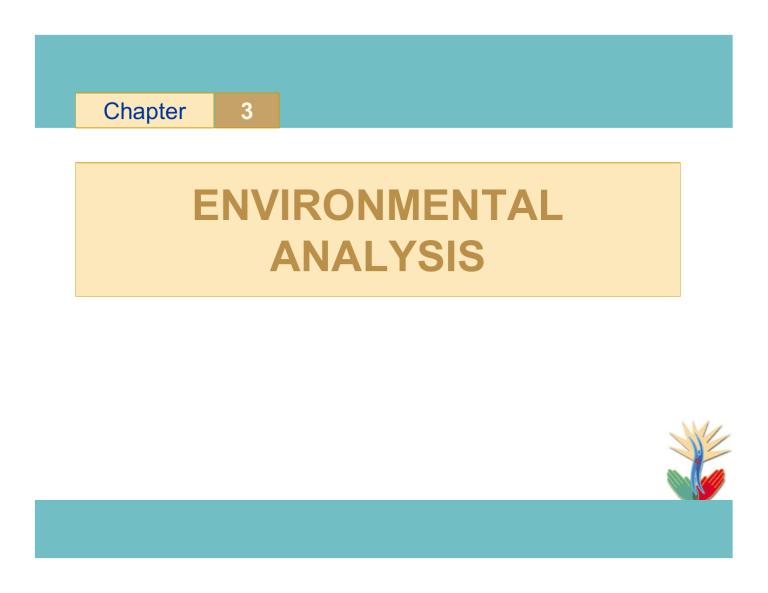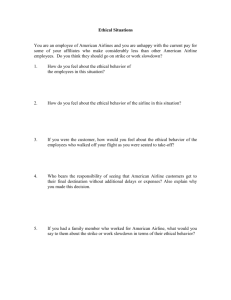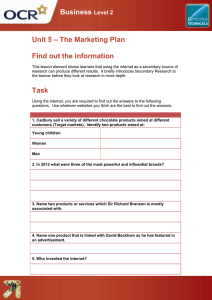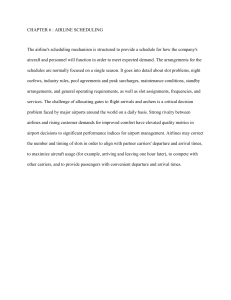
Chapter 3 ENVIRONMENTAL ANALYSIS Learning Objectives • After studying the chapter, you should be able to: – Explain why the ability to perceive, interpret, and respond to the organizational environment is crucial for managerial success. – Identify the main forces in an organization’s task and general environments, and describe the challenges that each force presents to managers. – Discuss the main ways in which managers can manage the organizational environment. – Define organizational culture and explain the role managers play in creating it. – Explain why managers should strive to create ethical organizational cultures. What Is the Organizational Environment • Organizational Environment – The set of forces and conditions that operate beyond an organization’s boundaries but affect a manager’s ability to acquire and utilize resources. – Forces and conditions change over time creating: • Opportunities for managers to enhance revenues, enter new markets, and strengthen the firm’s competitive position. • Threats to the firm from new competitors, economic downturns, and diminished access to critical resources. Forces in the Organizational Environment The General Environment (cont’d) • Political Forces – Outcomes of changes in laws and regulations, such as the deregulation of industries, the privatization of organizations, and increased emphasis on environmental protection • Increases in laws and regulations increase the costs of resources and limit the uses of resources that managers are responsible for acquiring and using effectively and efficiently. The General Environment • Economic Forces – Interest rates, inflation, unemployment, economic growth, and other factors that affect the general health and well-being of a nation or the regional economy of an organization – Managers usually cannot impact or control these. – Forces have profound impact on the firm. The General Environment (cont’d) • Sociocultural Forces – Pressures emanating from the social structure of a country or society or from the national culture • Social structure: the arrangement of relationships between individuals and groups in society • National culture: the set of values that a society considers important and the norms of behavior that are approved or sanctioned in that society. – Cultures and their associated social structures, values, and norms differ widely throughout the world. The General Environment • Technological Forces – Outcomes of changes in the technology that managers use to design, produce, or distribute goods and services • Results in new opportunities or threats to managers • Often makes products obsolete very quickly. • Can change how managers manage. The General Environment (cont’d) • Demographic Forces – Outcomes of change in, or changing attitudes toward, the characteristics of a population, such as age, gender, ethnic origin, race, sexual orientation, and social class • During the past two decades, women have entered the workforce in increasing numbers and most industrial countries’ populations are aging. • This will change the opportunities for firms competing in these areas as demands for child care and health care are forecast to increase dramatically. The General Environment (cont’d) • Global Forces – Outcomes of changes in international relationships; changes in nations’ economic, political, and legal systems; and changes in technology, such as falling trade barriers, the growth of representative democracies, and reliable and instantaneous communication – Important opportunities and threats to managers: • The economic integration of countries through free-trade agreements (GATT, NAFTA, EU) that decrease the barriers to trade. The Task Environment • Suppliers – Individuals and organizations that provide an organization with the input resources that it needs to produce goods and services • Raw materials, component parts, labor (employees) – Relationships with suppliers can be difficult due to materials shortages, unions, and lack of substitutes. • Suppliers that are the sole source of a critical item are in a strong bargaining position to raise their prices. – Managers can reduce these supplier effects by increasing the number of suppliers of an input. The Task Environment (cont’d) • Distributors – Organizations that help other organizations sell their goods or services to customers • Powerful distributors can limit access to markets through its control of customers in those markets. • Managers can counter the effects of distributors by seeking alternative distribution channels. The Task Environment (cont’d) • Customers – Individuals and groups that buy goods and services that an organization produces • Identifying an organization’s main customers and producing the goods and services they want is crucial to organizational and managerial success. The Task Environment (cont’d) • Competitors – Organizations that produce goods and services that are similar to a particular organization’s goods and services – Potential Competitors • Organizations that presently are not in the task environment but could enter if they so chose – Strong competitive rivalry results in price competition, and falling prices reduce access to resources and lower profits. The Task Environment (cont’d) • Barriers to Entry – Factors that make it difficult and costly for the organization to enter a particular task environment or industry – Economies of scale • Cost advantages associated with large operations – Brand loyalty • Customers’ preference for the products of organizations currently existing in the task environment. Barriers to Entry and Competition Figure 5.2 Managing the Organizational Environment • Environmental Change – The degree to which forces in the task and general environments change and evolve over time • Reducing the Impact of Environmental Forces – Top management: devise strategies that take advantage of opportunities and counter threats – Middle managers: collecting about competitors’ intentions, new customers, and new suppliers for the firm’s crucial or low-cost inputs – First-line managers: use resources efficiently and get closer to customers How Managers Use Functions to Manage Forces in the Task and General Environments Environmental Scanning In recent years, the line industry has become increasingly competitive. Since being deregulated during the 1970s in the U.S., long established airlines such as Pan American and Eastern have gone out of business as new upstarts like US West and Southwest have successfully entered the market. It appeared that almost anyone could buy a few used planes to serve the smaller cities that the larger airlines no longer wanted to serve. These lowcost, small-capacity commuter planes were able to make healthy profits in these markets where it was too expensive to land large jets. Rail and bus transportation either did not exist or was undesirable in many locations. Eventually the low-cost local commuter airlines expanded service to major cities and grabbed market share from the majors by offering cheaper fares with no-frills service. In order to be competitive with these lower cost upstarts, United Airlines and Northwest Airlines offered stock in the company and seats on the board of directors to their unionized employees in exchange for wage and benefit reductions. Delta and American Airlines, among other major earners, reduced their costs by instituting a cap on travel agent commissions. Travel agencies were livid at the cut in their livelihood, but they needed the airlines business in order to offer customers a total travel package. Globally it seemed as though every nation had to have its own airline for national prestige. These stateowned airlines were expensive, but the govern merits subsidized them with money and supporting regulations. For example, a foreign airline was normally only allowed to fly into one of a country's airports forcing travelers to switch to the national airline to go to other cities. During the 1970s and 1980s, however, many countries began privatizing their airlines as governments tried to improve their budgets. To be viable in an increasingly global industry, national or regional airlines were forced to form alliances and even purchase an airline in another country or region. For example, the Dutch KLM Air line acquired half interest in the U.S Northwest Airlines in order to obtain not only U.S. destinations, but also Northwest's Asian travel routes, thus making it one of the few global airline. Costs were still relatively high for the entire world’s major airlines because of the high cost of new airplanes. Just one new jet plane cost anywhere from $25 million to $100 million. By the 1990s, only three airfare manufacturers provided almost all of the commercial airliners: Boeing, Airbus, and McDonnell Douglas. Major airlines were forced to purchase new planes because they were more fuel efficient, safer, and easier to maintain. Airlines that chose to stay, with an older fleet of planes had to deal with higher fuel and maintenance costs-factors that often made it cheaper to buy new planes. Which of these forces is changing? What will this mean to the overall level of competitive intensity in the airline industry in the future? Would you invest or look for a job in this industry? Environmental Scanning In 1945, there were approximately 300 major home appliance manufacturers in the United States. By 1996, however, the "big five" Whirlpool, General Electric, A.B. Electrolux (no relation to Electrolux Corporation, a U.S. company selling Electrolux brand vacuum cleaners), Maytag, and Raytheon-controlled over 98% of the U.S. market. The consolidation, of the industry was a result of fierce domestic competition. Emphasis on quality and durability coupled with strong price competition drove the surviving firms to increased efficiencies and a strong concern for customer satisfaction. Prior to the World War II most appliance manufactures produced a limited line of appliances deriving from one successful product. General Electric made refrigerators. Maytag focused on washing machines. Hotpoint produced electric ranges. Each offered variations of its basic product, but not until 1945 did firms began to offer full lines of various appliances. By 1955 the major appliances industry began experiencing over capacity, leading to merges and acquisitions and proliferation of national and private brands. Product reliability improved even through real prices (adjusted for inflation) declined about 10%. Acknowledging that the U.S. major home appliance industry had reached maturity-future U.S. unit sales were expected to grow only 1%-2% annually on average for the foreseeable future. U.S. appliance makers decided to expand into Europe (where unit sales were expected to grow 5% annually). With Whirlpool's acquisition of the appliance business, of Philips (The Netherlands), GE's joint venture with GEC (United Kingdom), AB Electrolux's (Sweden) purchase of White in the United States, and Maytag's acquisition of Hoover (vacuum cleaners worldwide plus major home appliances in the UK), the level of competition increased dramatically in both Europe and North America during the 1990s. In addition, rapid economic growth in Asia as well as in Mexico 'and South America had tremendous implications for the emerging global appliance industry. Environmental scanning and industry analysis had to be international in scope if a firm was to succeed in, the 21st century. Organizational Culture • Organizational Culture – The set of shared values, norms, standards for behavior, and shared expectations that influence the way in which individuals, groups, and teams interact with each other and cooperate to achieve organizational goals. • Attraction-Selection-Attrition Framework – A model that explains how personality may influence organizational culture. • Founders of firms tend to hire employees whose personalities that are to their own, which may or may not benefit the organization over the long-term. CULTURE LAYERS Artifacts of Organizational Culture Organizational Culture Material Symbols Language Rituals Stories Beliefs Values Assumptions Innovation and Risk Taking Stability Attention to Detail Organizational Culture ` Outcome Orientation People Orientation Aggressiveness Time Orientation Model 1: As a Family Model 1: As a Family • • • • Centralization Role of top manager in org. Loyalty and respect on traditional value Build up the feeling of employee as family member • Adapt well with small org. Model 2: Eiffel Tower Model 2: Eiffel Tower • • • • Responsible and position in the hierarchy Rules and regulation Stable and Clear system/ Jobs description Sudden cases are not accepted • Germany firms Model 3: Rocket model Model 3: Rocket model • Decentralization • Creative and Innovation • Appropriate for Groups / Projects Model 3: Rocket model Model 4: Incubator • • • • • Competition Objectives Win-win solution Self-discipline – aggressive Facebook… Exhibit 9-3 How Organizational Culture Forms Philosophy of organization's founders Top management Organization's culture Selection criteria Socialization How to Change Culture • Have top-management people become positive role models, setting the tone through their behaviour. • Create new stories, symbols, and rituals to replace those currently in vogue. • Select, promote, and support employees who espouse the new values that are sought. • Redesign socialization processes to align with the new values. How to Change Culture • Change the reward system to encourage acceptance of a new set of values. • Replace unwritten norms with formal rules and regulations that are tightly enforced. • Shake up current subcultures through transfers, job rotation, and/or terminations. • Work to get peer group consensus through utilization of employee participation and creation of a climate with a high level of trust. Point-CounterPoint • Why Culture Doesn’t Change Culture develops over many years, and becomes part of how the organization thinks and feels Selection and promotion policies guarantee survival of culture Top management chooses managers likely to maintain culture • When Culture Can Change There is a dramatic crisis There is a turnover in leadership The organization is young and small There is a weak culture Ethical Organizational Cultures • Components of an Ethical Culture – Ethical values and norms are a central component of the organizational culture – A code of ethics guides decisions when ethical decisions arise. – Managers serve as ethical role models • Ethics Ombudsman – An ethics officer who monitors an organization’s practices and procedures to ensure they are ethical. Values and Ethics • Ethics converts values into action. • The right values can lead to competitive advantage. • Ethically-centered management focuses on quality of product rather than completion date. Ethical Temptations and Violations 1. 2. 3. 4. 5. 6. Stealing from employers and customers Illegally copying software Treating people unfairly Sexual harassment Conflict of interest (lose objectivity) Accepting kickbacks and bribes Ethical Temptations and Violations 7. Divulging confidential information 8. Misuse of corporate resources (“Let’s take the corporate jet to Cancun.”) 9. Corporate espionage (e.g., dumpster diving for dirt on the competition) 10. Poor cyberethics (e.g., stealing identities from résumés posted online) A Guide to Ethical Decision Making 1. 2. 3. 4. Is it right? Is it fair? Who gets hurt? Would you be comfortable if your decision were widely circulated? 5. Would you tell your child to do it? 6. How does it smell? Social Responsibility • Social Responsibility – A manager’s duty or obligation make decisions that promote the welfare and wellbeing of stakeholders and society as a whole. Background Concepts of Social Responsibility • Corporate social responsibility—obligations to society beyond profits • Stockholder viewpoint—only responsibility is to owners/stockholders • Stakeholder viewpoint—firm is responsible to all affected groups • Iron law—lose power if irresponsible • Corporate social performance—good citizen in the community Approaches to Social Responsibility Source: Figure 3.8 Approaches to Social Responsibility (cont’d) • Obstructionist response – Managers choose not to be socially responsible. – They behave illegally and unethically; hiding and covering up problems. Approaches to Social Responsibility (cont’d) • Defensive response – Managers stay within the law but make no attempt to exercise additional social responsibility. – Managers place shareholder interests above those of all other stakeholders. – Managers argue that society should pass laws and create rules if change is needed. Approaches to Social Responsibility (cont’d) • Accommodative response – Managers acknowledge the need to support social responsibility and try to balance the interests of different stakeholders against one another. • Proactive response – Managers actively embrace the need to behave in socially responsible ways and go out of their way to learn about needs of different stakeholders. – They are willing to utilize organizational resources for both stockholders and stakeholders.



